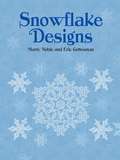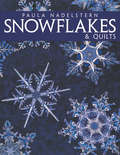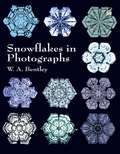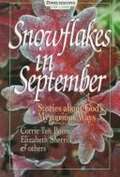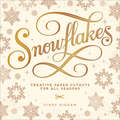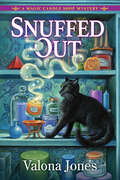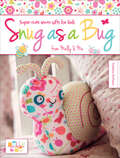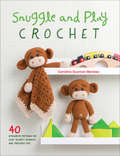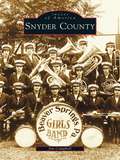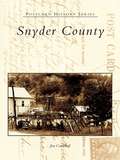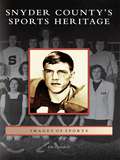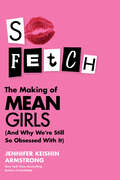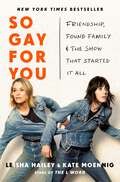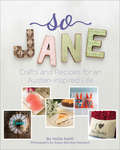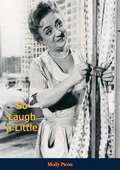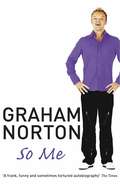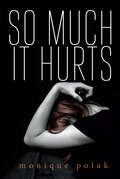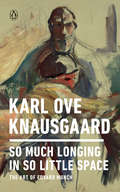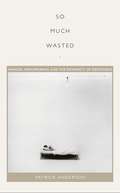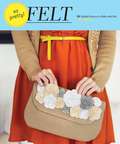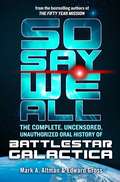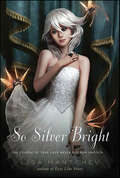- Table View
- List View
Snowflake Designs
by Marty Noble Eric GottesmanRich selection of more than 120 intricate images of snowflakes, based on photographs taken by W. A. Bentley (1865-1935) over a 50-year period, will provide an endless source of inspiration for artists, designers and decorators. Royalty-free black-and-white designs are ideal for use in textile and wallpaper designs, for needlework and craft projects.
Snowflakes & Quilts
by Paula NadelsternThe author of Kaleidoscope Quilts shows how to create a stunning snowflake quilt, including how to draft a design, make templates, and piece successfully.Paula’s incredible quilts capture the delicate, three-dimensional effect of winter’s snowflakes. Learn how to create the endless variations found in snowflakes using the techniques and materials of quilt making!• Full-size patterns for making 11 of the snowflake designs from Paula’s quilts• Step-by-step instructions explain how to draft a design, make templates, and piece successfully• Paula reveals her strip-piecing techniques for “Power Stitching”• Learn methods for using your fabrics to create “Seemingly Seamless Seams”“Paula explores the collision of precise geometry and lush splinters of color and pattern. In this book, she reveals her unique technique with characteristic intelligence and humor.” —Stacy C. Hollander, Senior Curator, Museum of American Folk Art, New York City“Much like a child mesmerized by fireflies, I cannot get enough of looking when I see [Paula’s] quilts. Riveting, dazzling, hypnotizing—these are the words that spring to mind when I behold Paula’s art.” —Kenneth R. Trapp, Curator-in-Charge, Renwick Gallery of the Smithsonian American Art Museum
Snowflakes in Photographs
by W. A. BentleyRemarkable revelations of nature's diversity, revealed in hundreds of snowflake images taken by American photographer Bentley during a 50-year period. Over 850 illustrations of snow crystals, with no two designs exactly alike, will inspire artists, designers, and craftspeople in search of extraordinary patterns for textiles, wallpaper, and other creative projects.
Snowflakes in September: Stories about God's Mysterious Ways
by Corrie Ten Boom Ernest Borgnine Caterine MarsallCorrie Ten Boom, Ernest Borgnine, and Elizabeth Sherrill are among the contributors to this unique collection. As they stir in the reader a sense of awe for the divine ways of God, the stories offer dramatic proof that God is an active part in the everyday lives of ordinary people.
Snowflakes: Creative Paper Cutouts for All Seasons
by Cindy HighamCreate unique paper snowflakes at home or in the classroom with 144 patterns designed for every season. Everyone can have fun using Snowflakes: Creative Paper Cutouts for All Seasons, creating one-of-a-kind designs for Christmas, Thanksgiving, Halloween, Valentine&’s Day, St. Patrick&’s Day, and other holidays, plus themes for winter, spring, summer, and fall. The 144 patterns are ideal for scrapbooking, holiday cards, and decorating. You can also use your snowflake patterns as quilt blocks, stencils, crochet patterns, wood ornaments, or patterns for stained glass! Use Snowflakes as a tool to learn the techniques and then begin experimenting on your own.
Snuffed Out (Magic Candle Shop Mystery #1)
by Valona JonesTwin sisters Tabby and Sage co-own a candle shop, but will it all go up in flames in Valona Jones&’ series debut, perfect for fans of Amanda Flower and Bailey Cates.30-year-old fraternal twins Tabby and Sage Winslow own The Book and Candle Shop in Savannah. Sage is hot-headed and impulsive while Tabby is calm and collected, making them the perfect partnership. When one of their customers is found murdered, from a blow to the head, that partnership is put to the test. Blithe McAdam had been seen in a heated argument with shop clerk Gerard, which immediately makes him suspect number one. The twins are convinced of Gerard&’s innocence and start digging into Blithe&’s past. But no one is cooperating. The neighbor who found the body isn&’t talking, medical examiner Quig won&’t give any details about the autopsy, and nasty rumors begin surfacing about the drowning of Blithe&’s father years earlier—evidence that could seal Gerard&’s fate. Tabby and Sage dig desperately for the truth. But it&’s not only their friend who&’s in peril. With the clock ticking, the twins find themselves in the grip of an unseen and deadly energy that has seeped into their midst—and in the sights of a ruthless killer.
Snug as a Bug: Super Cute Sewn Gifts for Kids from Melly & Me (Melly & Me: Fun Fabulous Design)
by Melanie McNeiceDiscover a colorful world of adorable bugs and pretty flowers with this collection of fun sewing projects that make perfect gifts! When pattern designer Melly McNeice created her Snug as a Bug fabric collection, she was inspired by the carefree florals and lovable insects. Now she shares her favorite project ideas based on her original designs.Whether it’s a pretty butterfly mobile for a new arrival, a cute snail toy for a little boy, or a handy ladybug bag for a girl, there’s something to delight kids of all ages. There’s even a fantastic applique quilt that is sure to become a treasured family heirloom. All of the designs are easy to create and made using Melly’s Snug as a Bug fabrics.
Snuggle and Play Crochet: 40 Amigurumi Patterns for Lovey Security Blankets and Matching Toys
by Carolina Guzman BenitezSimple patterns for cuddly characters and cozy blankets!Snuggle up with a crochet comforter or play with a colorful character—these amigurumi patterns are simple to stitch and super cute!Featuring unique crochet toy patterns including boy and girl dolls, dog and cat, bear and bunny, zebra, reindeer, monkey, and more, this amazing collection will give you a wide range of crochet toys and comfy blankets to create to delight the little ones in your life.
Snus!: The Complete Guide to Brands, Manufacturing, and Art of Enjoying Smokeless Tobacco
by Mats JonsonThe very first tell-all snus encyclopedia of its kind! You don't have to light up to enjoy tobacco! Swedish snus has a unique position in the world and is continually being developed through a thorough choice of tobacco, well-tested flavorings, and high quality production methods. Both large and small producers employ master blenders in order to create new and exciting snus products—all based on over 200 years of global expertise. A unique snus culture is developing and it’s one that has an exciting future ahead of it. More and more snus users are finding their way around the rich and varied range of products available and are starting to discover the rewards of choosing different snus varieties for different occasions. Today’s users take knowledge seriously, and just as we do with drinks, for example, we match our snus to different occasions. Snus is well on its way to becoming an integral component of the gastronomical experience.This volume on snus is the first of its kind. It covers today's modern snus, how it’s manufactured and who makes it, as well as which factors influence the end-result. It also goes over the history of snus, the myths that surround it, its failures, and its successes. The book also tells you how to taste-test and rate snus—and the art of enjoying it. It offers advice on how to buy and store it, and guides you through more than 200 tested and ranked varieties of snus.
Snyder County (Images of America)
by Jim CampbellSince its formation in 1855, Snyder County has played many important roles. It was a key link in the nation's first mass-transit system, the Pennsylvania Canal; the home of the commonwealth's last three-term governor, Simon Snyder; and the seat of one of the nation's oldest coeducational colleges, Susquehanna University. Snyder County explores this area's rich history through beautiful photographs, many of which were culled from treasured family albums. While this volume commemorates more than one hundred fifty years of history, particular attention is paid to the period from 1860 to 1960 through two hundred original photographs, many of which are published here for the first time.
Snyder County (Postcard History Series)
by Jim CampbellSince its formation in 1855, Snyder County has played many important roles. It was a key link in the nation's first mass-transit system, the Pennsylvania Canal; the home of the commonwealth's last three-term governor, Simon Snyder; and the seat of one of the nation's oldest coeducational colleges, Susquehanna University. Snyder County explores this area's rich history through beautiful photographs, many of which were culled from treasured family albums. While this volume commemorates more than one hundred fifty years of history, particular attention is paid to the period from 1860 to 1960 through two hundred original photographs, many of which are published here for the first time.
Snyder County's Sports Heritage (Images of Sports)
by Jim CampbellIf Snyder County sports fans are not the most rabid in the nation, they certainly are among the most rabid. Regardless of the community, regardless of the sport or level at which it is played, Snyder County teams enjoy unconditional support second to none. Through the years, Snyder County has seen more than its share of athletic greatness. Those highly successful athletes, as well as those who played just for the love of the game, are represented in the more than 200 new and different images in this volume.
So Fetch: The Making of Mean Girls (And Why We're Still So Obsessed With It)
by Jennifer Keishin ArmstrongFrom the New York Times bestselling author of Seinfeldia comes the totally fetch story of one of the most iconic teen comedies of all time, Mean Girls, revealing how it happened, how it defined a generation, “like, invented” meme culture, and why it just won’t go away, filled with exclusive interviews from the director, cast, and crew. Get in, loser. We’re going back to 2004.It’s been 20 years since Mean Girls hit theaters, winning over critics and audiences alike with its razor-sharp wit, star-making turns for its then unknown cast, and obsessively quotable screenplay by Tina Fey. Fast forward two decades and Mean Girls remains as relevant as ever. Arguably, no other movie from the 2000s has had as big of an impact on pop culture.In So Fetch, New York Times bestselling author of Seinfeldia, Jennifer Keishin Armstrong, offers the first ever authoritative book about this beloved classic that shaped an entire generation. Based off revealing interviews with the director, cast, and crew, So Fetch tells the full story of the making of Mean Girls, from Tina Fey’s brilliant adaptation of a self-help guide for parents of teen girls, to the challenges of casting Lindsay Lohan, Rachel McAdams, and the iconic supporting players. So Fetch also explores the film’s lasting cultural influence, from its role in the rise of Y2K tabloid culture, impact on girls of all ages and lgbtq+ culture, to how we use it to define female relationships to this day.Timed for the 20th anniversary and the release of the new movie musical adaptation, So Fetch is the perfect companion for fans and anyone who understands that when it comes to Mean Girls’ enduring legacy, the limit does not exist!
So Gay for You: Friendship, Found Family, and the Show That Started It All
by Kate Moennig Leisha Hailey*AN INSTANT NEW YORK TIMES BESTSELLER*An intimate, hilarious memoir of art, friendship, queerness, and found family by Kate Moennig and Leisha Hailey, stars of The L Word—including never-before-shared stories and photos from behind the scenes of the show and their personal lives. "Are you comfortable with nudity?" my manager asked.In the early 2000s, Kate Moennig and Leisha Hailey—both young artists trying to figure it all out—met at auditions for an unknown little TV show. Given that it was a show about lesbians living in Los Angeles, with the first ever ensemble cast of openly queer female characters, Kate and Leisha knew the project was going to be unlike anything else out there—that is, if it even got picked up.Then, one million people watched the premiere. The show, which came to be called The L Word, turned into a trailblazing phenomenon. Its influence on pop culture, in the political arena, and in the lives of viewers has been lasting, impactful, even life-saving. And in addition to changing the course of television history, The L Word changed Kate and Leisha's lives forever. Suddenly, they were the faces of lesbian culture in a society still hostile to queerness. And one of them wasn't even out yet.Luckily, they had each other. From their first day on set, Kate and Leisha were so inseparable that the cast joked they were like a pair of pants—you couldn't have one leg without the other. Hence the name for their branded partnership and podcast, PANTS, launched in 2020 and downloaded over twenty million times.This friendship has seen Kate and Leisha through their greatest triumphs and most painful moments, stumbling from closeted queer kids to LGBTQ+ activists, actors, podcasters, and business owners. Full of never-before-shared glimpses into the making of The L Word, Kate and Leisha's real-life loves and losses, and their experiences as queer icons, So Gay for You is a heartfelt, inspiring love letter to a ride or die friendship over the decades, and a testament to the liberating power of chosen family.
So Jane: Crafts and Recipes for an Austen-Inspired Life
by Hollie KeithAusten lovers, get more Jane in your life through decorating, gift giving, or entertaining with these creative crafts and delectable recipes. In honor of Jane&’s two-hundredth birthday, authors Hollie Keith and Jennifer Adams present thirty craft ideas and thirty recipes organized into six chapters bearing the titles of Jane Austen&’s novels. Enthusiasts can enjoy breakfast in Bath, via Northanger Abbey by creating Decorative Egg Cozies to keep their Soft-Boiled Eggs warm, or serve Honey-Lemon Teaspoons with Rose Petal Tea at the Middletons&’ of Sense and Sensibility. Enjoy a picnic that Emma would love to have shared with Mr. Knightly, or create an I Heart Mr. Darcy Pillow that all Elizabeth Bennett wannabes would love to cuddle up with. Whether you&’re throwing an Austen party for friends or looking to pass the time on a rainy afternoon, So Jane is sure to entertain.
So Laugh a Little
by Molly Picon Eth Clifford RosenbergMolly Picon, lauded Jewish actress, reminisces about her upbringing and career through the relationship with her fascinating Grandmother.“The famous Yiddish actress, who for half a century has been playing vaudeville circuits around the world, starring in the Yiddish Theatre in New York and currently winning all hearts in her first Broadway role in Milk and Honey, has written a sort of I Remember Grandma. Her Grandmother must have been quite a person. She came to Philadelphia from Russia and had a finger in raising Molly. From the time Molly was five she was fascinated by the theatre—and Grandmother put all sorts of hurdles in her way. She did constructive things for the family, too, helped them to better homes, to more food, to guard them in their opening lives. She even moved to New York to keep an eye on Molly after her marriage to her manager. The family encouraged her to believe she did a good deal of managing of their affairs, and her interest in Molly’s success never lagged, even when she passed the eighty mark. Her fineness, her humor, her philosophy comes through and there’s also a good deal of Molly in the blend. An inside picture of Jewish family life but rather special in appeal.”—Kirkus ReviewsSubtitled – “Hilarious Hints on How to be a Jewish Grandmother”
So Me
by Graham NortonGraham Norton, whose impish charm and quick wit has earned him a place in our hearts, looks back at his life so far. In his own words, SO ME is 'a real romp through a journey from living in a cockroach-infested council flat in Hackney to buying Claudia Schiffer's townhouse in Manhattan, from my mother dragging me to school to me dragging her to Sharon Stone's house for New Year's brunch'.From a not-so miserable Irish childhood to dropping out of Cork University and joining a commune of hippies in San Francisco, from his disastrous attempts at becoming a serious actor to the rise of his comedy career in London, this is a hilarious, insightful and moving account of a colourful life.
So Me
by Graham NortonGraham Norton, whose impish charm and quick wit has earned him a place in our hearts, looks back at his life so far. In his own words, SO ME is 'a real romp through a journey from living in a cockroach-infested council flat in Hackney to buying Claudia Schiffer's townhouse in Manhattan, from my mother dragging me to school to me dragging her to Sharon Stone's house for New Year's brunch'.From a not-so miserable Irish childhood to dropping out of Cork University and joining a commune of hippies in San Francisco, from his disastrous attempts at becoming a serious actor to the rise of his comedy career in London, this is a hilarious, insightful and moving account of a colourful life.
So Much It Hurts (Young Adult Novels)
by Monique PolakIris is an aspiring actress, so when Mick, a well-known visiting Aussie director, takes an interest in her, she's flattered. He's fourteen years older, attractive, smart, charming and sexy—in other words, nothing like her hapless ex-boyfriend, Tommy. But when Iris and Mick start a secret relationship, she soon witnesses Mick's darker side, and his temper frightens her. Before long, she becomes the target of his rage, but she makes endless excuses for him. Isolated and often in pain, Iris struggles to continue going to school, where she is preparing for her role as Ophelia. When her family and friends begin to realize that something is terribly wrong, Iris defends her man, but she also takes the first tentative steps toward self-preservation.
So Much Longing in So Little Space: The Art of Edvard Munch
by Karl Ove KnausgaardA brilliant and personal examination by sensational and bestselling author Karl Ove Knausgaard of his Norwegian compatriot Edvard Munch, the famed artist best known for his iconic painting The ScreamIn So Much Longing in So Little Space, Karl Ove Knausgaard sets out to understand the enduring and awesome power of Edvard Munch’s work by training his gaze on the landscapes that inspired Munch and speaking firsthand with other contemporary artists, including Anselm Kiefer, for whom Munch’s legacy looms large. Bringing together art history, biography, and memoir, Knausgaard tells a passionate, freewheeling, and pensive story about not just one of history’s most significant painters, but the very meaning of choosing the artist’s life, as he himself has done. Including reproductions of some of Munch’s most emotionally and psychologically intense works, chosen by Knausgaard, this utterly original and ardent work of criticism will delight and educate both experts and novices of literature and the visual arts alike.
So Much Wasted: Hunger, Performance, and the Morbidity of Resistance
by Patrick AndersonIn So Much Wasted, Patrick Anderson analyzes self-starvation as a significant mode of staging political arguments across the institutional domains of the clinic, the gallery, and the prison. Homing in on those who starve themselves for various reasons and the cultural and political contexts in which they do so, he examines the diagnostic history of anorexia nervosa, fasts staged by artists including Ana Mendieta and Marina Abramović, and a hunger strike initiated by Turkish prisoners. Anderson explores what it means for the clinic, the gallery, and the prison when one performs a refusal to consume as a strategy of negation or resistance, and the ways that self-starvation, as a project of refusal aimed, however unconsciously, toward death, produces violence, suffering, disappearance, and loss differently from other practices. Drawing on the work of Martin Heidegger, Sigmund Freud, Giorgio Agamben, Peggy Phelan, and others, he considers how the subject of self-starvation is refigured in relation to larger institutional and ideological drives, including those of the state. The ontological significance of performance as disappearance constitutes what Anderson calls the "politics of morbidity," the embodied, interventional embrace of mortality and disappearance not as destructive, but rather as radically productive stagings of subject formations in which subjectivity and objecthood, presence and absence, and life and death are intertwined.
So Pretty! Crochet: Inspiration and Instructions for 24 Stylish Projects
by Amy PalanjianTwo dozen delightful crochet patterns from countries around the world. Stitch up super-stylish handmade goodies with So Pretty! Crochet. Craft expert and editor Amy Palanjian presents twenty-four irresistible projects—from craft stars around the world from Portugal to Latvia to Australia and beyond. You&’ll find patterns for delicate necklaces, a soft and cozy hat and gloves, chic headbands, a darling garland, sweet nesting bowls, and much more. With detailed instructions, helpful charts, crafty anecdotes, and stunning color photographs showcasing the oh-so-pretty projects, this vibrant collection elevates the classic craft of crochet and makes it perfectly stylish for today!
So Pretty! Felt
by Amy PalanjianSoft, fashionable, easy to find, and fun to work with, felt is a crafter's dream material. This stylish collection presents 24 simple yet elegant projects to make with felt--chic headbands, sweet flower bouquets, adorable package toppers, gorgeous necklaces, and more. Crafters of all skill levels will be reaching for their stash to get started! With stunning photography, helpful how-to illustrations, and plenty of inspiration, So Pretty! Felt uses this popular material in new and unexpected ways for oh-so-pretty results.
So Say We All: The Complete, Uncensored, Unauthorized Oral History of Battlestar Galactica
by Edward Gross Mark A. AltmanFrom Mark A. Altman and Edward Gross, the bestselling authors of the definitive two-volume Star Trek oral history, The Fifty-Year Mission, comes the complete, uncensored, unauthorized oral history of Battlestar Galactica in So Say We All.Four decades after its groundbreaking debut, Battlestar Galactica—both the 1978 original and its 2004 reimagining have captured the hearts of two generations of fans. What began as a three-hour made for TV movie inspired by the blockbuster success of Star Wars followed by a single season of legendary episodes, was transformed into one of the most critically acclaimed and beloved series in television history. And gathered exclusively in this volume are the incredible untold stories of both shows—as well as the much-maligned Galactica 1980.For the first time ever, you will learn the unbelievable true story of forty years of Battlestar Galactica as told by the teams that created a television legend in the words of over a hundred cast, creators, crew, critics and executives who were there and brought it all to life. So Say We All!At the Publisher's request, this title is being sold without Digital Rights Management Software (DRM) applied.
So Silver Bright (Theatre Illuminata)
by Lisa MantchevAll Beatrice Shakespeare Smith has ever wanted is a true family of her own. And she's close to reuniting her parents when her father disappears. Now Bertie must deal with a vengeful sea goddess and a mysterious queen as she tries to keep her family – and the Theatre Illuminata – from crumbling. To complicate it all, Bertie is torn between her two loves, Ariel and Nate.
